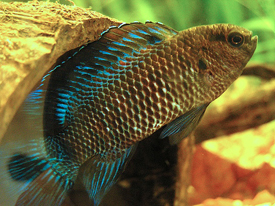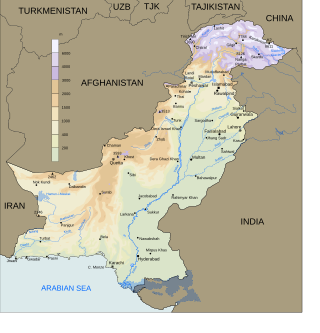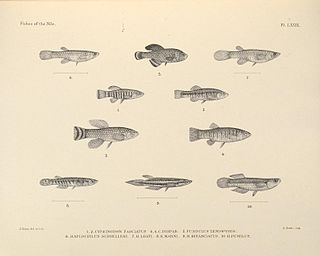
Gadiformes, also called the Anacanthini, are an order of ray-finned fish that include the cod, hakes, pollock, haddock, burbot, rocklings and moras, many of which are food fish of major commercial value. They are mostly marine fish found throughout the world and the vast majority are found in temperate or colder regions while a few species may enter brackish estuaries. Pacific tomcods, one of the two species that makes up the genus Microgadus, are able to enter freshwater, but there is no evidence that they breed there. Some populations of landlocked Atlantic tomcod on the other hand, complete their entire life cycle in freshwater. Yet only one species, the burbot, is a true freshwater fish.

Lake Manchar, also spelled Manchhar, is the largest natural freshwater lake in Pakistan, and one of the largest in South Asia. It is located west of the Indus River, in Jamshoro and Dadu districts of Sindh, 18 kilometres (11 mi) away from Sehwan. Lake Manchar collects water from numerous small streams in the Kirthar Mountains, and then empties into the Indus River. The lake's surface area fluctuates with the seasons, from as little as 36 km2, to as much as 500 km2 during monsoon rains.

The blue panchax or whitespot is a common freshwater fish found in a large variety of habitats due to its high adaptability. This species is native to southern Asia from Pakistan, India to Indonesia. It has been discovered in two hot springs in Singapore. Identified by a white-coloured spot on its head, the species can reach up to 9 cm (3.5 in) in length; it tends to keep to the surface of the water, and controls the mosquito population by feeding on their larvae.

The rohu, rui, ruhi or roho labeo is a species of fish of the carp family, found in rivers in South Asia. It is a large omnivore and extensively used in aquaculture.

Catla, also known as the major South Asian carp, is an economically important South Asian freshwater fish in the carp family Cyprinidae. It is native to rivers and lakes in northern India, Bangladesh, Myanmar, Nepal, and Pakistan, but has also been introduced elsewhere in South Asia and is commonly farmed.

The Panjkora River is a river in the Khyber Pakhtunkhwa province in north-west Pakistan. The river runs through the mountainous northern part of the province, and forms the Kumrat Valley. It passes from Dir, Timergara, and joins with Swat River at Chakdara. It is generally characterized by steep slopes on either side of the riverbank covered in thick forests. The river has a large catchment area, making the river susceptible to significant flooding – most notably during the 2010 floods that occurred throughout much of Pakistan. It was named after Panjkora clan, a sub-clan in Mamyali section of Swati tribe which inhabited this region during 12 and 16 centuries and currently living in Hazara Division.

The greenstripe barb, silver barb or striped barb is a tropical freshwater and brackish fish belonging to the subfamily Cyprininae of the family Cyprinidae. It originates in inland waters in Asia, and is found in Pakistan, India, and Sri Lanka.

The yoyo loach, Almora loach or Pakistani loach is a freshwater fish belonging to the loach family Botiidae. It originates in the slow-running and still waters of the Ganges basin in northern India and possibly Nepal. Despite the alternative common name Pakistani loach, the true B. almorhae is not known from Pakistan.

Freshwater fish are fish species that spend some or all of their lives in bodies of fresh water such as rivers, lakes and inland wetlands, where the salinity is less than 1.05%. These environments differ from marine habitats in many ways, especially the difference in levels of osmolarity. To survive in fresh water, fish need a range of physiological adaptations.

Fishing in India is a major sector within the economy of India contributing 1.07% of its total GDP. The fishing sector in India supports the livelihood of over 28 million people in the country, especially within the marginalized and vulnerable communities. India is the third largest fish producing country in the world accounting for 7.96% of the global production and second largest producer of fish through aquaculture, after China. The total fish production during the FY 2020-21 is estimated at 14.73 million metric tonnes. According to the National Fisheries Development Board the Fisheries Industry generates an export earnings of Rs 334.41 billion. Centrally sponsored schemes will increase exports by Rs 1 lakh crore in FY25. 65,000 fishermen have been trained under these schemes from 2017 to 2020. Freshwater fishing consists of 55% of total fish production.

Badis badis, also known as the blue perch or blue badis, is a small species of Asian freshwater fish in the family Badidae of the order Anabantiformes. It is found in ponds, rivers, ditches and swamps in northern India, eastern Pakistan, Bangladesh, Bhutan and Nepal, including the Ganges, Brahmaputra, Mahanadi and Indus basins. It is sometimes kept as an aquarium fish. It is a small, predatory fish that feeds on tiny invertebrates. Maximum total length is around 8 cm (3 in). It is sexually dimorphic, with males growing larger and more colorful, especially when excited, compared to females. Adult males have blue fins and may display dark vertical bands on the flanks, while the smaller females display little color. Several similar relatives, now recognized as separate Badis species, have historically been confused with Badis badis. Historically the two genera that now make up the Badidae, Badis and Dario, were placed in the family Nandidae; this is no longer the case.

Pakistan's native fauna reflect its varied climatic zones. The northern Pakistan, which includes Khyber Pakhtunkhwa and Gilgit Baltistan, has portions of two biodiversity hotspots, Mountains of Central Asia and Himalayas.
Labeobarbus dainellii is a species of ray-finned fish in the genus Labeobarbus which is endemic to Lake Tana in Ethiopia.

The mrigal carp, also known as the white carp, is a species of ray-finned fish in the carp family. Native to streams and rivers in India, the only surviving wild population is in the Cauvery River, leading to its IUCN rating as vulnerable. It is widely aquafarmed, and introduced populations exist outside its native range. It reaches a maximum length of 1 m (3.3 ft). This species and Cirrhinus mrigala are considered distinct.

The fishing industry plays a significant part in the national economy of Pakistan. With a coastline of about 650 miles, Pakistan has enough fishery resources that remain to be developed. Most of the population of the coastal areas of Sindh and Balochistan depends on fisheries for livelihood. It is also a major source of export earning.

Securicula gora is a species of cyprinid fish found in Bangladesh, India, Pakistan and possibly in Nepal. It is the only species in its genus.

The Badidae or the chameleonfishes are a small family or ray-finned fishes which has been placed in the order Anabantiformes. Despite their apparent affinity to other Anabantiforms, the 5th edition of Fishes of the World classifies the family as being a sister to the Anabantiformes, along with the Nandidae and Pristolepididae in an unnamed and unranked but monophyletic clade which is a sister to the Ovalentaria within the wider Percomorpha. Members of this family are small freshwater fish that are found in Bangladesh, Bhutan, China, India, Laos, Myanmar, Nepal, Pakistan and Thailand. The largest is Badis assamensis that reaches a standard length of up to 7.5 cm (3 in), while the smallest, Dario dario, does not exceed 2 cm (0.8 in).

The Arabian toothcarp, known also as the Arabian toothcarp or mother-of-Pearl fish is a species of killifish belonging to the family Aphaniidae. It can be found from the shores of the Red Sea south to Ethiopia, the Gulf of Aden, the Arabian Sea and along the Persian Gulf east to Pakistan and India. It is also found in the Suez Canal, the northern coast of the Sinai Peninsula, and in one location on the Palestinian coast. The former recognized subspecies: A. d. richardsoni, the Dead Sea toothcarp endemic to the Dead Sea has now been raised to a full species as Aphaniops richardsoni.















